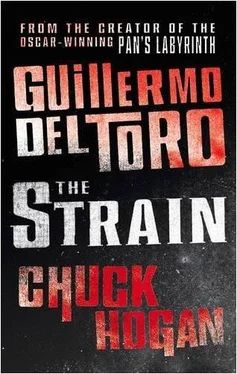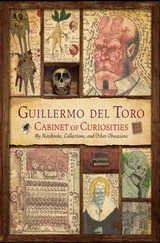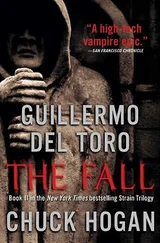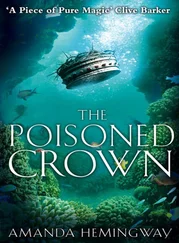The secret of his interior wellspring of youth? One simple element.
Revenge.
Many years before, in Warsaw and later in Budapest, there was a man named Abraham Setrakian who had been an esteemed professor of Eastern European literature and folklore. A Holocaust survivor who survived the scandal of marrying a student, and whose field of study took him to some of the darkest corners of the world.
Now, an aged pawnbroker in America, still haunted by unfinished business.
He had good soup left over, delicious chicken soup with kreplach and egg noodles, that a regular had brought him all the way from Liebman’s, in the Bronx. He put the bowl in the microwave and worked at his loose necktie knot with his gnarled fingers. After the beeping, he carried the hot bowl over to the table, pulling a linen napkin — never paper! — from the holder and tucking it snugly into his collar.
Blowing on soup. A ritual of comfort, of reassurance. He remembered his grandmother, his bubbeh —but this was more than mere memory; it was sense , a feeling —blowing on it for him when he was a boy, sitting next to him at the rickety wooden table in the cold kitchen of their house in Romania. Before the troubles. Her old breath stirring the rising steam into his young face, the quiet magic of that simple act. Like blowing life into the child. And now, as he blew, an old man himself, he watched his breath given shape by the steam, and wondered just how many of these respirations he had left.
He took the spoon, one of a drawer full of fancy, mismatched implements, into the crooked fingers of his left hand. Blowing onto the spoon now, rippling the tiny pool of broth there, before taking it into his mouth. Taste came and went, the buds on his tongue dying like old soldiers: the victims of many decades of pipe smoking, a professor’s vice.
He found the thin remote for the outdated Sony TV — a kitchen model finished in white — and the thirteen-inch screen warmed up, further illuminating the room. He rose and walked to the pantry, leaning his hands on the stacks of books squeezing the hallway into a narrow tread of worn rug — books were everywhere, piled high against the walls, many of them read, all of them impossible to part with — and lifting the cover off the cake tin to retrieve the last of the good rye bread he had been saving. He carried the paper-wrapped loaf back to his cushioned kitchen chair, settling heavily, and went about picking off the little bits of mold as he enjoyed another tender sip of the delicious broth.
Slowly, the image on the screen claimed his attention: a jumbo jet parked on a tarmac somewhere, lit up like an ivory piece upon jeweler’s black felt. He pulled on the black-rimmed glasses that hung at his chest, squinting in order to make out the bottom graphic. Today’s crisis was taking place across the river, at JFK Airport.
The old professor watched and listened, focused on the pristine-looking airplane. One minute became two, then three, the room fading around him. He was transfixed — nearly transported — by the news report, the soup spoon still in his no-longer-tremulous hand.
The television image of the dormant airplane played across the lenses of his eyeglasses like a future foretold. The broth in the bowl cooled, its steam fading, dying, the picked-apart slice of rye bread remaining uneaten.
He knew .
Pick-pick-pick.
The old man knew—
Pick-pick-pick.
His malformed hands began to ache. What he saw before him was not an omen — it was an incursion. It was the act itself. The thing he had been waiting for. That he had been preparing for. All his life until now.
Any relief he had felt initially — at not having been outlived by this horror; at getting one last-minute chance at vengeance — was replaced immediately by sharp, painlike fear. The words left his mouth on a gust of steam.
He is here…He is here…
Regis Air Maintenance Hangar
Because JFK needed the taxiway cleared, the entire aircraft was towed as is into the Regis Air long-span maintenance hangar in the hour before dawn. No one spoke as the lame 777 full of dead passengers rolled past like an enormous white casket.
Once the wheel chocks were put down and the airplane was secured, black tarpaulins were laid out to cover the stained cement floor. Borrowed hospital screens were erected to curtain off a wide containment zone between the left wing and the nose. The plane was isolated in the hangar, like a corpse inside a massive morgue.
At Eph’s request, the Office of the Chief Medical Examiner of New York dispatched several senior medicolegal investigators from Manhattan and Queens, bringing with them several cartons of rubber crash bags. The OCME, the world’s largest medical examiner’s office, was experienced in multiple-casualty disaster management, and helped devise an orderly process of cadaver retrieval.
Port Authority HAZMAT officers in full contact suits brought out the air marshal first — solemnly, officers saluting the bagged corpse as it appeared at the wing door — and then, laboriously, everyone else in the first row of coach. They then removed those emptied seats, using the added space to bag the corpses before evacuating them. Each body, one at a time, was strapped to a stretcher and lowered from the wing to the tarp-covered floor.
The process was deliberate and, at times, gruesome. At one point, about thirty bodies in, one of the Port Authority officers suddenly stumbled away from the retrieval line moaning and gripping his hood. Two fellow HAZMAT officers converged on him, and he lashed out, shoving them into the hospital screens, in effect breaching the containment border. Panic erupted, people clearing the way for this possibly poisoned or infected officer clawing at his containment suit on his way out of the cavernous hangar. Eph caught up with him out on the apron, where, in the light of the morning sun, the officer succeeded in throwing off his hood and peeling off his suit, like a constricting skin. Eph grabbed the man, who then sank down onto the tarmac, sitting there with sweaty tears in his eyes.
“This city,” sobbed the officer. “This damn city.”
Later, word went around that this Port Authority officer had worked those hellish first few weeks on the pile at Ground Zero, first as part of the rescue mission, and then the recovery effort. The specter of 9/11 still hung over many of these Port Authority officers, and the current bewildering mass-casualty situation had brought it crashing down again.
A“go team” of analysts and investigators from the National Transportation Safety Board in Washington, D.C., arrived aboard an FAA Gulfstream. They were there to interview all involved with the “incident” aboard Regis Air Flight 753, to document the aircraft’s final moments of navigability, and to retrieve the flight-data recorder and the cockpit voice recorder. Investigators from the New York City Department of Health, having been leapfrogged by the CDC in the crisis response, were briefed on the matter, though Eph rejected their jurisdiction claim. He knew he had to keep control of the containment response if he wanted it done right.
Boeing representatives en route from Washington State had already disclaimed the 777’s complete shutdown as “mechanically impossible.” A Regis Air vice president, roused from his bed in Scarsdale, was insisting that a team of Regis’s own mechanics be the first to board the aircraft for inspection, once the medical quarantine was lifted. (Corruption of the air-circulation system was the current prevailing cause-of-death theory.) The German ambassador to the United States and his staff were still awaiting their diplomat’s pouch, Eph leaving them cooling their heels in Lufthansa’s Senator Lounge inside terminal 1. The mayor’s press secretary made plans for an afternoon news conference, and the police commissioner arrived with the head of his counterterrorism bureau inside the rolling headquarters of the NYPD’s critical response vehicle.
Читать дальше












